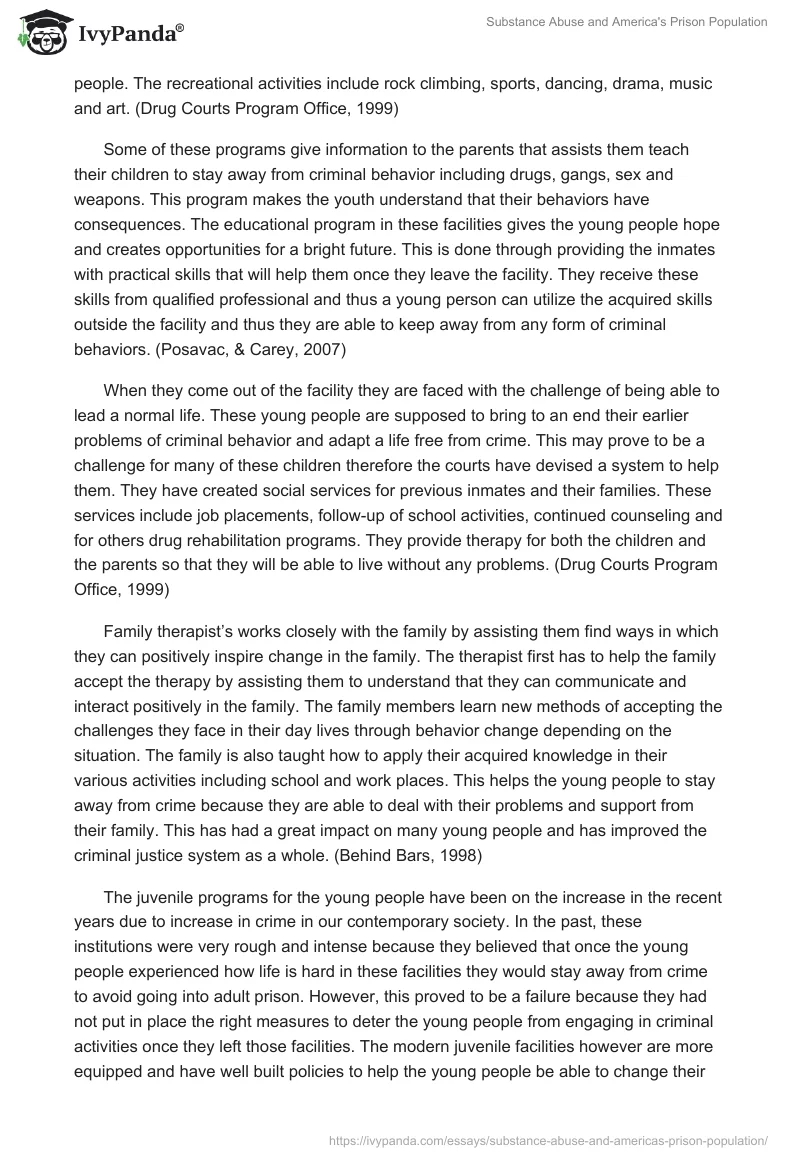The criminal justice system includes policies that the government puts in place within the various institutions in order to maintain social order, prevent and alleviate crime within the society. The justice system also ensures that those who break the law receive due punishment and rehabilitation efforts as deserved.
The criminal justice programs provide a set of activities that are carried out in various institutions to help the law offenders come to terms with their various crimes. These programs are geared towards accomplishing particular set objectives to the concerned individuals. These programs are evaluated to ensure that they are effective to perform the required duties. There are a number of programs in the criminal justice system that include rehabilitation centre for mentally handicapped, substance abuse prevention programs as well as juvenile delinquency programs. (Drug Courts Program Office, 1999)
The juvenile delinquency program gives the young person a chance to receive assistance from the state. The program is considered successful in the way it prepares the young people to go back to their communities without engaging in criminal behavior any longer. Most of this young people are tried in adult courts for engaging in violent criminal activities.
Every inmate in these facilities is supposed to participate in the various educational facilities provided. They are also supposed to meet certain standards put in place by the facility on a one-on-one basis. The program is geared towards providing young adults with an opportunity to prove that they can change and go back to their communities and live normal lives. (Behind Bars, 1998)
The Juvenile program offers an opportunity for the community to prevent the young people stay away from criminal behavior and efficiently rehabilitate the young wrongdoers. It is aimed at helping the community teach the young offenders that their obligations are to their victims more than to the state. The young people are given an opportunity to learn meaningful methods of making a living once they leave the program.
The program helps the young offenders’ with appropriate ways of spending their free time through sports and other activities such as community groups and individuals are selected to monitor their behavior. They are able to spend time with adults and other young people in the society thus allowing them connect with other people. The recreational activities include rock climbing, sports, dancing, drama, music and art. (Drug Courts Program Office, 1999)
Some of these programs give information to the parents that assists them teach their children to stay away from criminal behavior including drugs, gangs, sex and weapons. This program makes the youth understand that their behaviors have consequences. The educational program in these facilities gives the young people hope and creates opportunities for a bright future.
This is done through providing the inmates with practical skills that will help them once they leave the facility. They receive these skills from qualified professional and thus a young person can utilize the acquired skills outside the facility and thus they are able to keep away from any form of criminal behaviors. (Posavac, & Carey, 2007)
When they come out of the facility they are faced with the challenge of being able to lead a normal life. These young people are supposed to bring to an end their earlier problems of criminal behavior and adapt a life free from crime. This may prove to be a challenge for many of these children therefore the courts have devised a system to help them. They have created social services for previous inmates and their families. These services include job placements, follow-up of school activities, continued counseling and for others drug rehabilitation programs. They provide therapy for both the children and the parents so that they will be able to live without any problems. (Drug Courts Program Office, 1999)
Family therapist’s works closely with the family by assisting them find ways in which they can positively inspire change in the family. The therapist first has to help the family accept the therapy by assisting them to understand that they can communicate and interact positively in the family. The family members learn new methods of accepting the challenges they face in their day lives through behavior change depending on the situation.
The family is also taught how to apply their acquired knowledge in their various activities including school and work places. This helps the young people to stay away from crime because they are able to deal with their problems and support from their family. This has had a great impact on many young people and has improved the criminal justice system as a whole. (Behind Bars, 1998)
The juvenile programs for the young people have been on the increase in the recent years due to increase in crime in our contemporary society. In the past, these institutions were very rough and intense because they believed that once the young people experienced how life is hard in these facilities they would stay away from crime to avoid going into adult prison.
However, this proved to be a failure because they had not put in place the right measures to deter the young people from engaging in criminal activities once they left those facilities. The modern juvenile facilities however are more equipped and have well built policies to help the young people be able to change their behavior and go back to the society as changed people. The criminal justice programs should be improved and put up to standard in order to ensure that the young offenders are able to change their lifestyle for the good of the society.
References List
Behind Bars. (1998). Substance Abuse and America’s Prison Population, New York, NY: Columbia University.
Drug Courts Program Office. (1999). Looking at a Decade of Drug Courts, 1999 Update, Washington, DC: The American University.
Posavac, J.E, & Carey, G.R. (2007).program evaluation: methods and case studies (7th ed.), Pearson Prentice Hall, University of Michigan. Print


